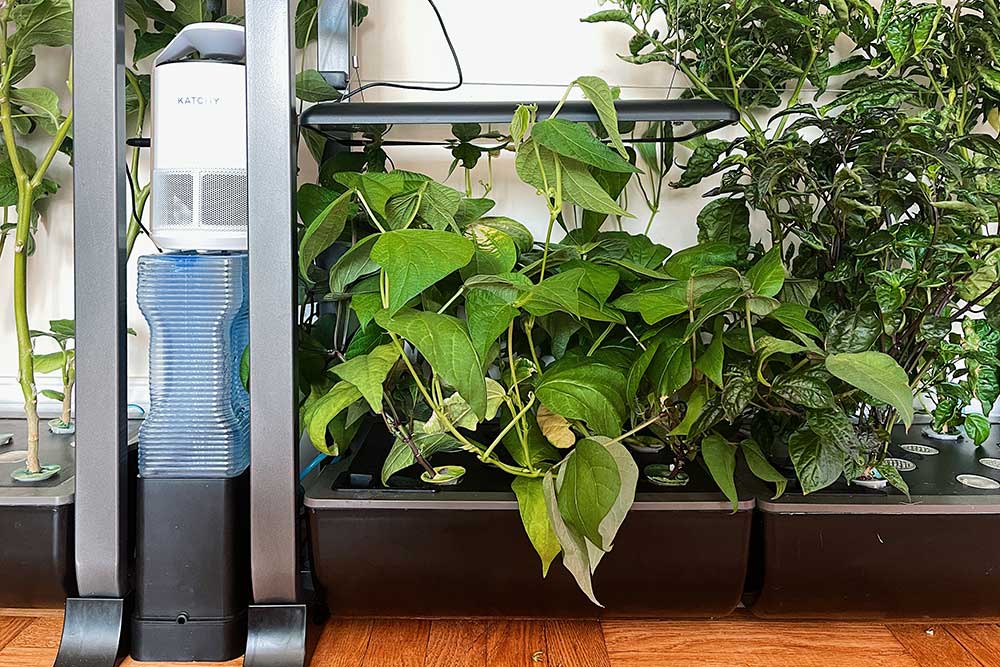
Indoor Gardening
Ever since I started my indoor gardens, I’ve gotten lots of the same questions from friends, family and random internet strangers.
So in today’s post, I thought I’d answer the most commonly asked questions about gardening indoors, and specifically, beginner hydroponics!
Gardening Indoors
Frequently Asked Questions
- What is Hydroponics and Why Do You Prefer It?
- What Plants Can You Grow in Hydroponics?
- What Plants Can You Grow Indoors?
- How Bad is the Electric Bill
- Where Can I Buy an Indoor Garden?
- What’s the Best Indoor Garden Brand?
- Which Indoor Garden Machine Is Your Favorite?
- Do You Have to Use Specific Pods or Can You Buy Regular Vegetable Seeds?
- What’s the Coolest Thing You’ve Grown?
- What’s the Cost Per Plant?
- Can You Grow Tomatoes Indoors?
- How Long Does It Take to Grow a Pepper Plant?
- What Are Your Favorite Asian Greens to Grow Indoors?
- Can You Grow Watermelon Indoors?
- How Much Maintenance Is Involved?
- What Type of Nutrition Do You Use?
- How Often Do You Change the Water?
- Do You Have Advice for Getting Started?
- Do You Throw Away the Plant Once You Harvest the Leaves?
- What About Gnats and Bugs?
- How Expensive Is It to Maintain?
- Is It Worth It?
.
What is Hydroponics
Hydroponics is simply a gardening method where plants are grown in water instead of soil.
I grow everything indoors, from start to finish, so I really wanted to minimize the risk of bugs and pests.
I hate bugs, with a passion and I didn’t want to deal with slugs, caterpillars, moths, beetles… you name it, I did not want it.
While you can start an indoor garden with soil, the same way you would garden outdoors, soil is primarily where most pests come from.
Bugs lay their eggs in soil and damp soil can attract gnats and other flying pests, so eliminating soil gets rid of the pest problem.

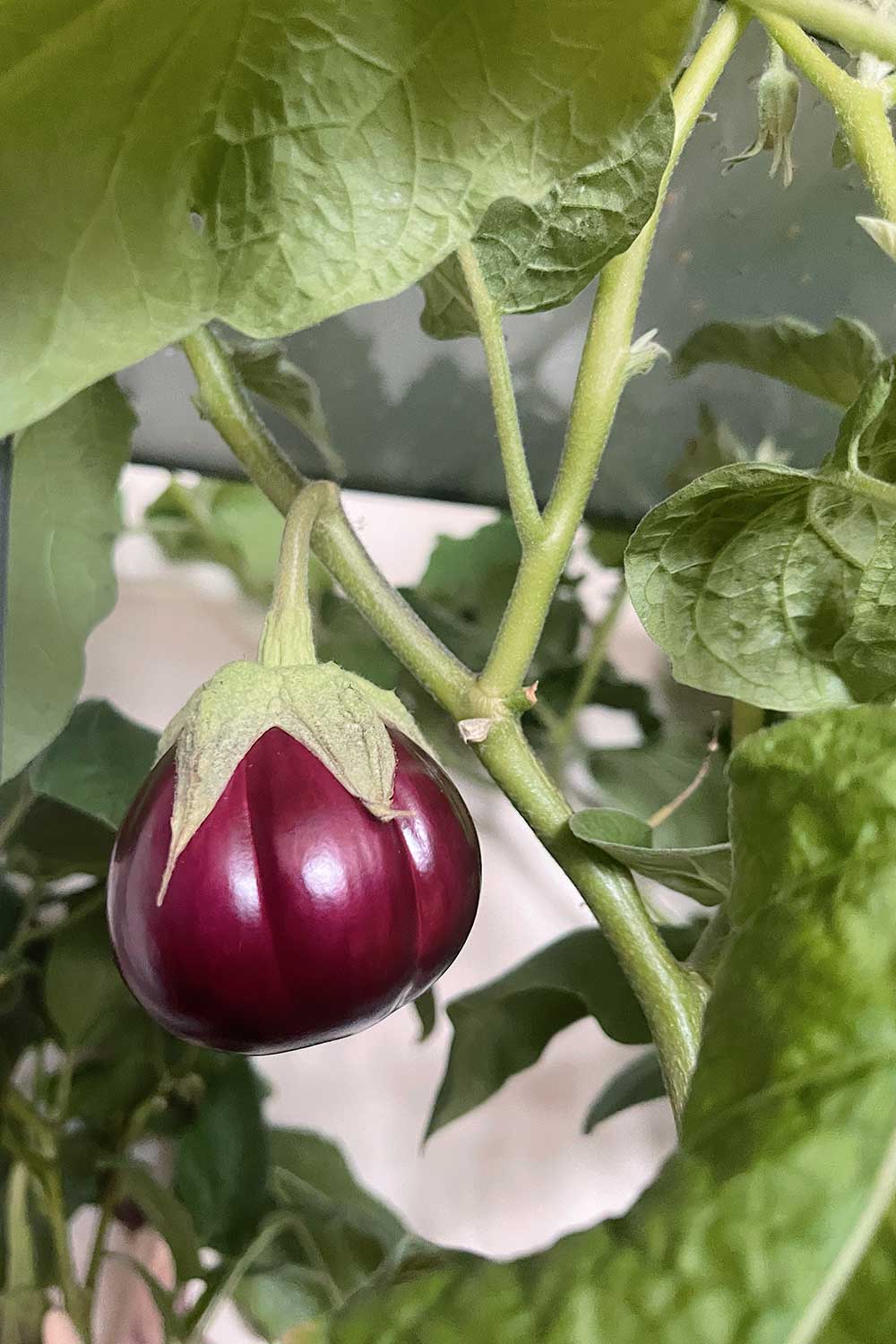
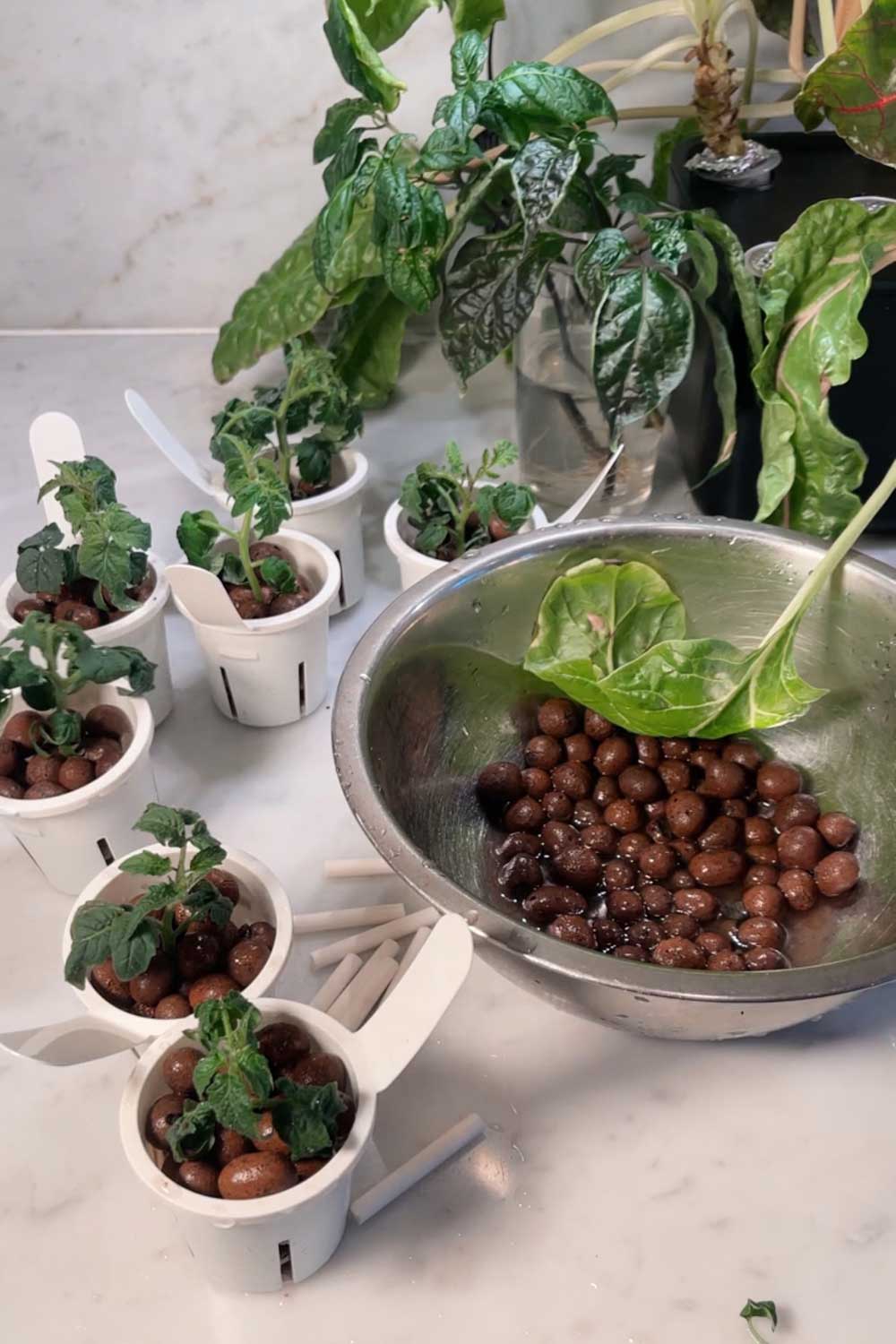
hydroponics is the fastest, cleanest + most efficient form of gardening
The other benefit of hydroponics is that it’s much faster!
I am incredibly impatient and some vegetables, like tomatoes and hot peppers, can take a while to grow.
Plants grown hydroponically receive all the nutrients they need without having to push their roots through soil or seek out water.
So, they grow significantly faster (5x as fast!) in hydroponic set ups vs traditional soil.
Those are the 2 main reasons I prefer to go hydroponically – less bugs + faster growth.
.
What Plants Can Be Grown Hydroponically?
Pretty much anything can be grown hydroponically!
Strawberries, tomatoes, lettuce, cucumbers, watermelon.. practically every fruit and vegetable can be adapted to a hydroponic environment.
I started posting a series on Youtube about different hydroponic growing experiments, which you can check out here to get an idea of different plants that I’ve grown.
With that being said, some plants thrive more than others in a wet water-based environment.
Lettuces and any type of salad green does well in hydroponics.
Romaine, swiss chard, bok choy, tatsoi, etc will grow incredibly fast and healthy in even the most basic hydroponic set up.
In fact, most of the salad greens that you buy at the grocery store have been grown commercially in hydroponic farms.
But there are always certain plants that don’t like wet roots.
Spinach can be tricky, peas have a hard time seed starting.. it takes a bit of trial and error to figure out!
In general, if a plant can be grown hydroponically, I think it’s a better method than traditional soil.
Hydroponics is cleaner, faster and (can be) cheaper than traditional gardening.
.
What Vegetables Can You Grow Indoors?
Hydroponic gardening can be done outdoors or indoors.
If growing entirely from start to finish indoors, you’ll have to provide some sort of lighting during the winter months (or all year round if your apartment doesn’t receive enough natural sunlight).
I use all-in-one gardens like Aerogarden and Click & Grow because they look really sleek and pretty.
They also integrate lighting, a water bowl and a scheduled timer all in one.
I also have inexpensive machines like Ahopegarden and DIY projects I’ve made myself that cost virtually nothing, like these kratky mason jars.
So when it comes to growing indoors, I can theoretically grow anything, but I’m limited by space and electricity costs.
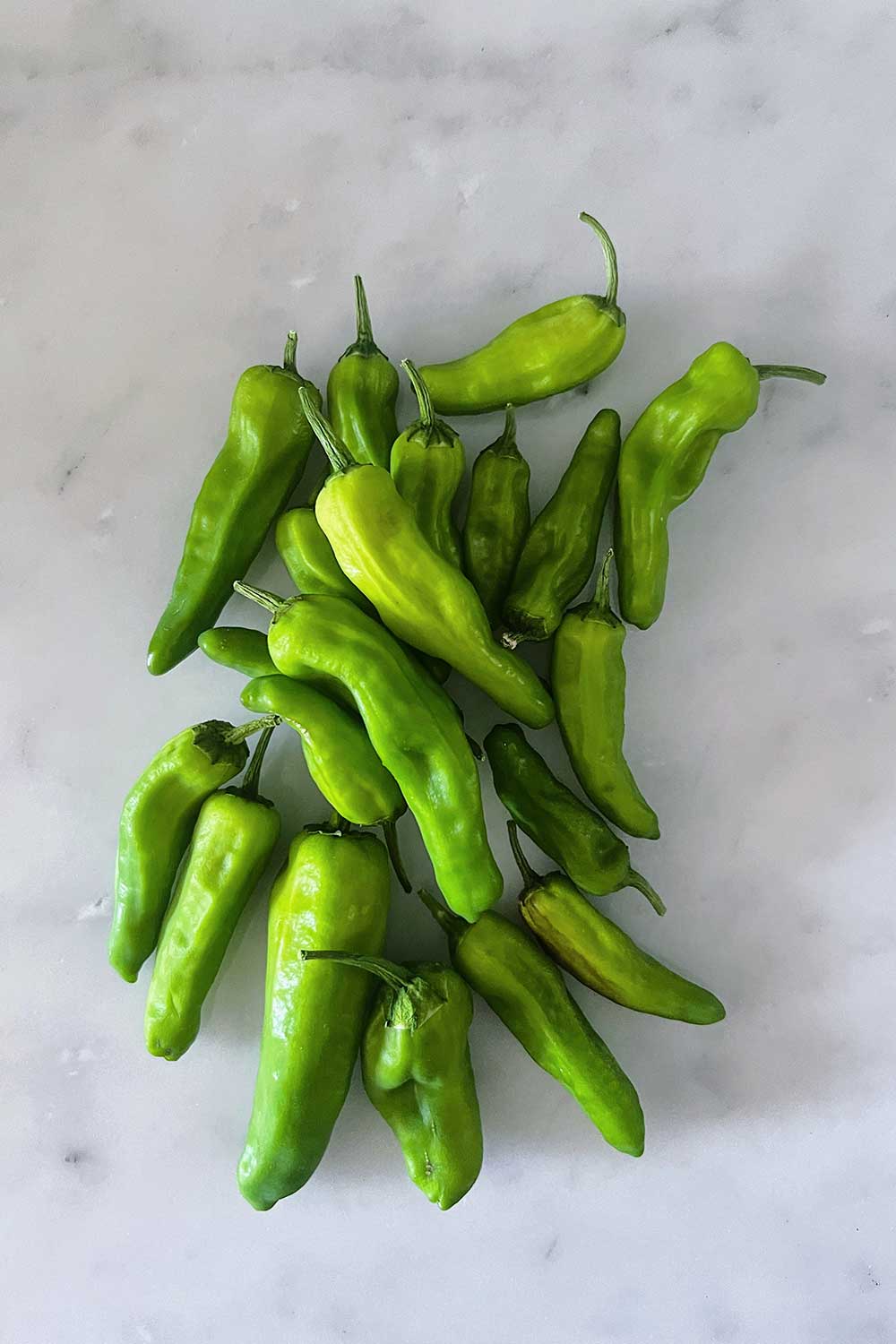
some vegetables i’ve grown indoors – rainbow swiss chard, shishito peppers & herbs
I always recommend growing your own herbs, lettuces and salad greens.
They taste so much better fresh, grow quickly and are very inexpensive. Meanwhile, buying fresh herbs and greens at the grocery store can add up!
Plus, when you grow your own herbs and lettuces, you tend to get much larger, healthier plants with higher levels of antioxidants that are entirely pesticide free.
Commercially grown lettuce that you find at the grocery store can often harbor bacteria.
In fact, every now and then you’ll see recalls for salad greens because they’ve been contaminated with bacteria, rodent feces, deer faces, etc.
Gross!
.
How Much Does Indoor Gardening Impact Electricity Bills
Indoor smart gardens are very energy efficient because they use LED lights – so the short answer is not much!
Running a garden inside your home will add a dollar or two extra a month (depending on the size of the garden).
But no one ever seems to believe me, so I broke down the math and wrote a whole post here explaining how much LED lights will cost you!
Read more: Do Indoor Gardens Increase Your Electric Bill?The very first garden I got was the Aerogarden Harvest.
It’s a compact, countertop garden with space for up to 6 plants and the built-in lights on the machine are 20 watt LEDs.
The Harvest garden consumes 23 watts of electricity and I typically have it running for 16 hours a day.
I live in New York City and my provider is Con Edison (who recently got approval to jack up rates by 9% ugh but that’s another story…).
According to the EPA, New York is roughly average in the nation for electric costs.
My most recent bill, from July 2023 during peak summer season rates, showed electricity supply costs at 14.309 cents per kilowatt hour (c/kWh).
To calculate how much energy an Aerogarden (or any indoor garden) uses, the formula is:
Hours x Wattage x 30 days a month x Utility Supply Cost
where
- Hours = # of hours a day the Aerogarden is on
- Wattage = wattage used by the indoor smart garden (varies by model). Divide by 1000 to get kilowatts
- Utility cost = cost per kilowatt hour charged by your local utility company
So, running the Aerogarden Harvest for 16 hours a day at 0.023 kilowatts of power x 30 days x 0.14309 cents/kWh added an extra $1.58 to my monthly bill.
And that’s at the current high summer season rates.
I typically run my gardens at night, and June is typically one of the highest utility bills all year, so the monthly cost is usually a bit lower.
And actually if you grow ‘efficiently’, you actually save money by indoor gardening.
What I mean by growing efficiently is you prioritize growing vegetables that are a little pricey at the grocery store and tend to spoil quickly (like herbs and salad greens).
For example, I can grow 6 herbs in the Aerogarden Harvest.
Buying a small tiny packet of herbs at the grocery store is roughly $2.50 a pack in NYC, or $15 for six. So I’m actually saving about $13 by growing my own!
If I were to grow lettuce or salad greens, which usually cost me about $5 a box for organic at Whole Foods, the cost savings would be even greater.
Not to mention the personal satisfaction of growing your own veggies :)
Electricity costs have only gotten higher and higher.
But the sad part is most of the bill is from the utility company’s delivery charges, not your usage.
Or at least, it is in my case here in NYC. 62% of my bill is ConEd’s delivery charges.
In any case, the actual cost of the added electricity usage will depend on your location, your local electricity rates and the type of indoor gardens you’re using.
Some brands, like Click & Grow, use even less wattage than the Aerogarden.
If you primarily want to grow lettuce and salad greens (aka plants that don’t require much electricity), I recommend getting a Click & Grow.
I have a whole post comparing the two most popular indoor garden brands here.
Read more: Aerogarden vs Click & Grow: Which Is Better?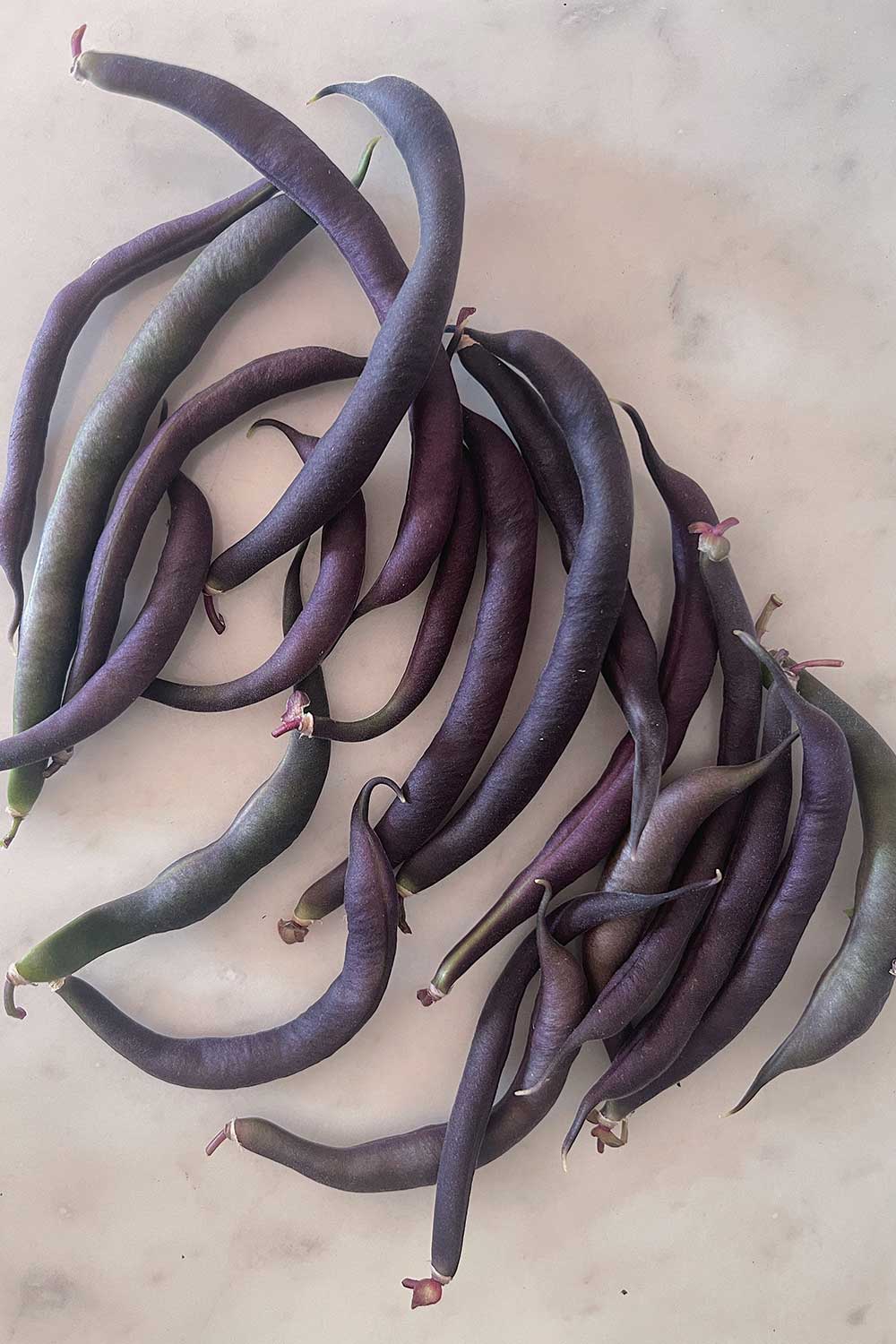
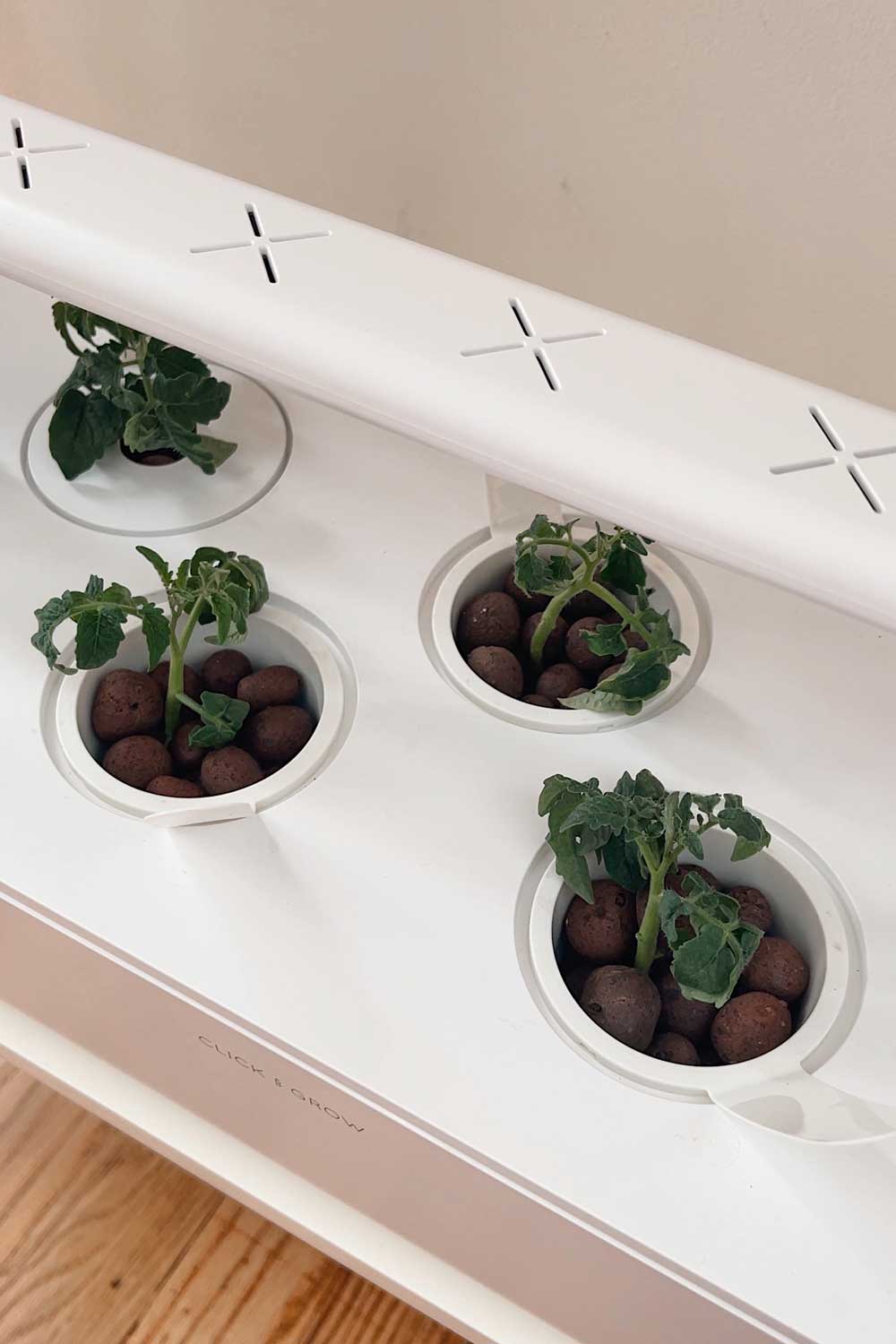
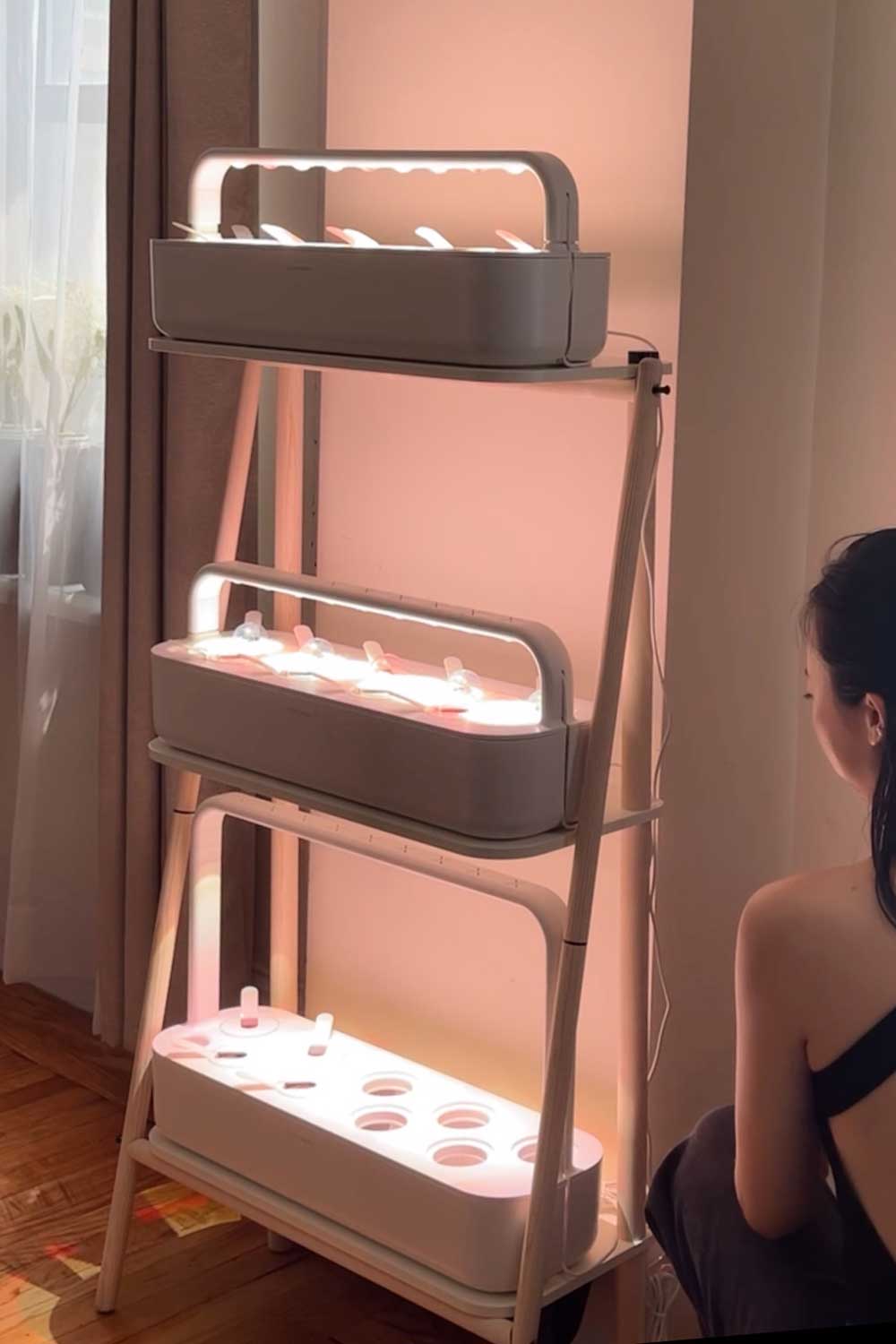
.
Where Can I Buy an Indoor Garden?
When I first started growing indoors in my tiny apartment, the only brand to offer hydroponic smart gardens was Aerogarden.
They’re like the OG of indoor gardening, and they offer hydroponic gardens in all different sizes, shapes and colors!
But nowadays, there are tons of knock-off companies and new companies offering indoor gardens for personal use.
I have this compact, inexpensive option from AHopeGarden as well as this sleek vertical garden from Click & Grow.
I also have a ton of really affordable indoor gardens from Amazon.
Btw, I have discount codes to help you save a little if you want to try out an indoor garden!
Aerogarden Discount Code
Use SSG15 for 15% off any order of $50+
Click & Grow Discount Code
Use SSG for 25% off site wide
.
What’s the Best Indoor Garden Brand?
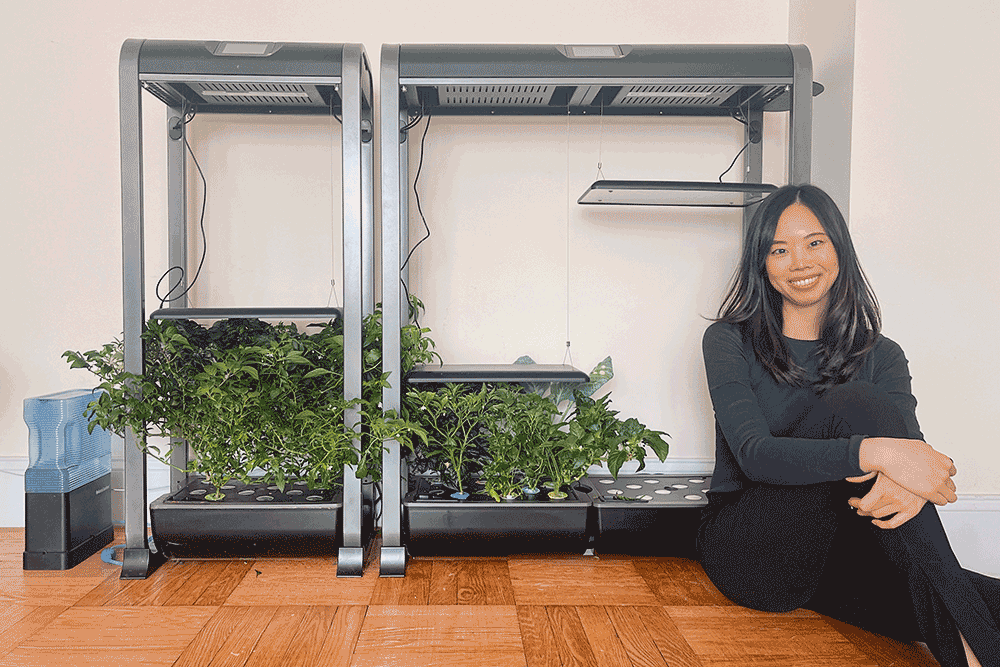
I have the most indoor gardens from Aerogarden.
As the original indoor garden company, they’ve been making mini hydroponic machines for years and offer great quality products at a reasonable price.
They often run sales, especially around the holidays, and over the years I’ve picked up more and more from them because their gardens are great.
I especially love their floor models, the Farm series.
I have two Farm 24 XLs and one Farm 12 XL and it’s in these large machines that I grow eggplants, hot peppers, cucumbers, beans, etc.
The floor models have up to 3 feet of vertical growing height so you can grow almost anything!
If you like experimenting and trying out new types of plants, Aerogarden gives you the most flexibility.
Aerogarden also has great customer service.
Occasionally, I’ll have an issue and their customer service team takes a couple days to respond, but always sorts out the problem.
They’ve replaced seed pods that haven’t germinated, replaced a display panel that broke prematurely and also sent me a new LED light panel when one of mine stopped working.
If you’re on a budget, you can find inexpensive ‘knock-off’ versions of the Aerogarden on Amazon.
They aren’t as easy to use straight out of the box, so I would recommend these budget friendly machines for an experienced gardener.
These machines tend to come with less instructions, and no seed pods, so you have to be comfortable with seed starting on your own and already know the basics about pruning and nutrition.
While the inexpensive Amazon indoor gardens don’t have all the bells and whistles, they’re still a great affordable way to grow lots of plants indoors!
I primarily use them for Asian greens and lettuces.
If you want to grow fresh herbs and veggies but prefer a more hands off approach, I recommend Click & Grow.
Their indoor garden systems are more ‘pre-set’ – sort of like a nespresso machine for gardening.
Just pop in the plant pods, occasionally top up the machine with water and plants will grow on their own.
With Click & Grow, you would buy their plant pods and smart soil, and the machines themselves are a bit more expensive.
But they make by far the prettiest indoor gardens, so if budget is no object but time is precious, Click & Grow is the best solution!
I have a more in-depth breakdown of the differences between Aerogarden and Click & Grow in this post.
.
Which Indoor Garden Machine Is Your Favorite?
My ‘favorite’ has changed over the years ha.
Currently it’s the Aerogarden Bounty Elite. It’s fairly priced, compact and has 50W LED lights, so it can handle everything from herbs and lettuces to fruiting plants.
The Bounty Elite has a height capacity of 2 feet, so I’ve grown lots of fruiting plants like shishito peppers and dwarf cherry tomatoes, and the tomatoes in particular have always tasted amazing.
I like the digital display, how you can customize the light schedule and even add a sunrise/sunset feature and I think the LEDs are particularly great for fruiting plants.
I also love that it’s compact and counter-top friendly.
It’s much easier maintaining indoor gardens when I can see them every morning right in my kitchen, vs bending down to the floor!
.
Do You Have to Use Specific Pods or Can You Buy Regular Vegetable Seeds?
You can use your own seeds!
All of the indoor garden companies have pod ‘slots’ where 1 pod = 1 plant.
Aerogarden and Click & Grow sell their own pods, with tons of herb, veggie, fruit and flower options, but you can also use your own seeds.
I have a guide for how to use your own seeds in the Aerogarden in this post.
When you’re just starting out, I recommend buying each company’s pods.
They’ve carefully selected and bred compact varieties that will grow best indoors, so it’s much easier to use their pods.
But, if you enjoy experimenting you can also buy your own seeds, which is what I mainly do now.
It’s a little more difficult using your own seeds (I’ve bought the wrong varieties many times) but also so much more rewarding!
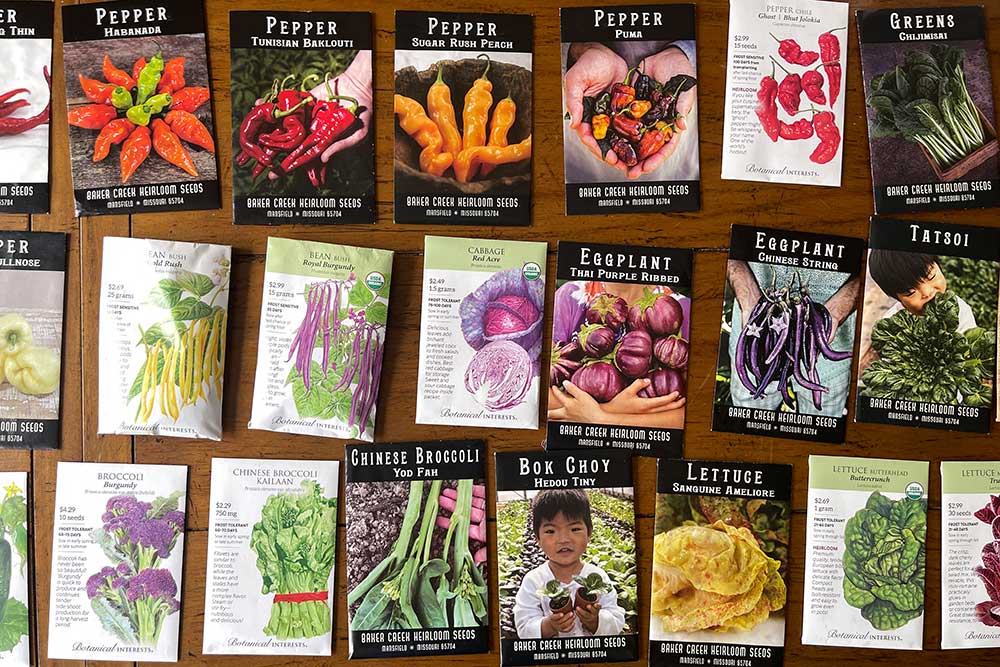
just a fraction of the seeds I’ve bought. once you start gardening indoors, it becomes an addiction! I want to try growing everything ha
.
What’s the Coolest Thing You’ve Grown?
I like to grow unique varieties of veggies that I’ve never seen before.
So for me, that’s mainly Asian greens and vegetables and heirloom varieties of tomatoes and hot peppers.
Right now, I’m having fun growing purple beans and Asian eggplants like these Chinese string eggplants and Thai ribbed eggplants!
I’m also experimenting with growing really large vegetables like zucchini and squash.
But someday I’d like to grow cabbage, melons and watermelons…
current experiments: Chinese eggplant, Korean peppers & Orange Hat cherry tomatoes
.
What’s the Cost Per Plant?
In general, gardening is a fairly cheap hobby.
The main start up cost is the indoor gardens themselves, which can be a bit pricey.
I have discount codes you can use to save a bit!
But aside from the initial investment, the machines themselves are re-usable so the recurring cost is mainly electricity, seeds, and nutrition.
I already covered how much indoor gardening affects my utility bills above, and seeds and nutrition aren’t very much.
Seed packets cost $0.99 to ~$4, depending on the variety.
Powder hydroponic nutrients cost ~$20 for a bag that can last years.
So the cost per plant is pretty negligible!
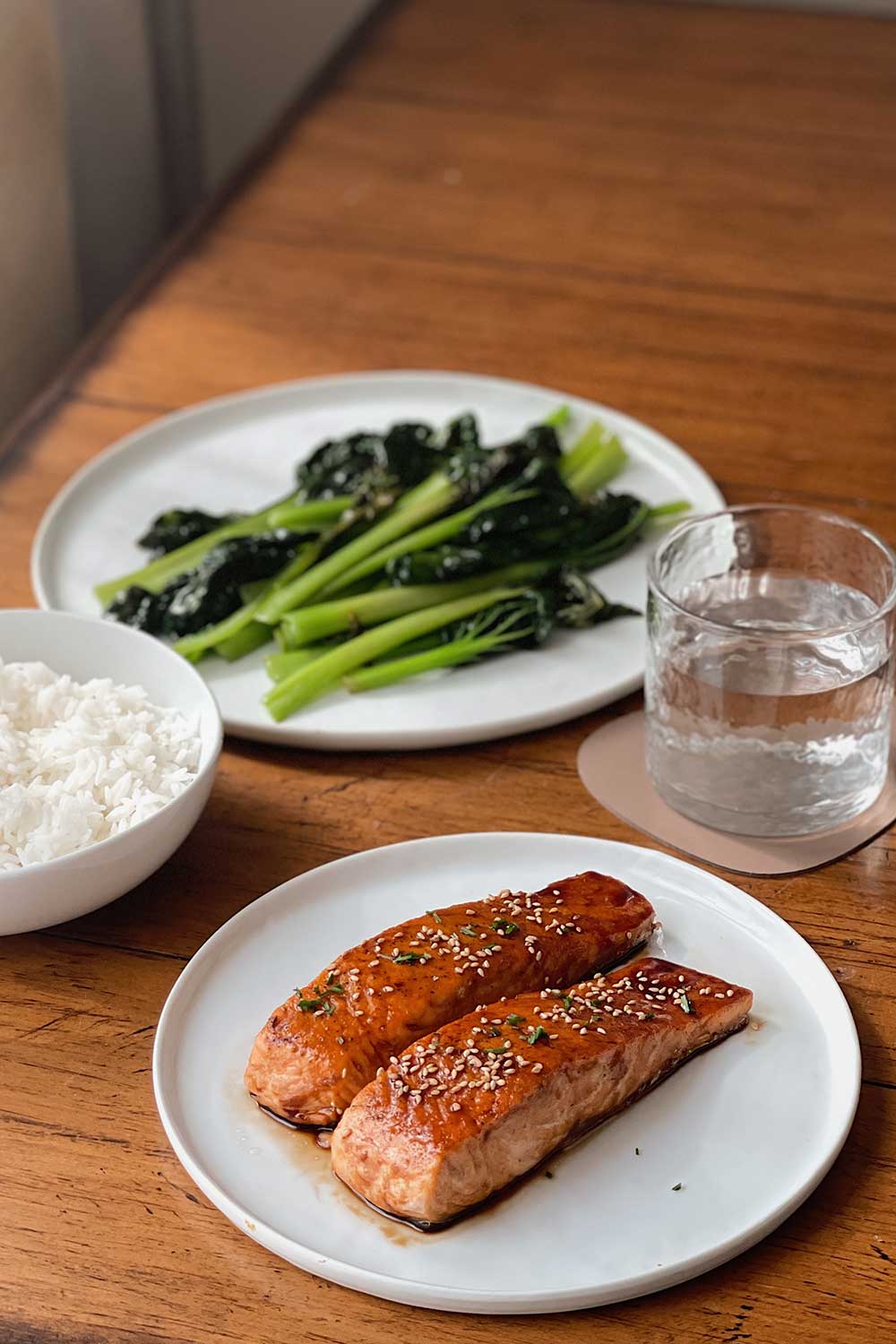
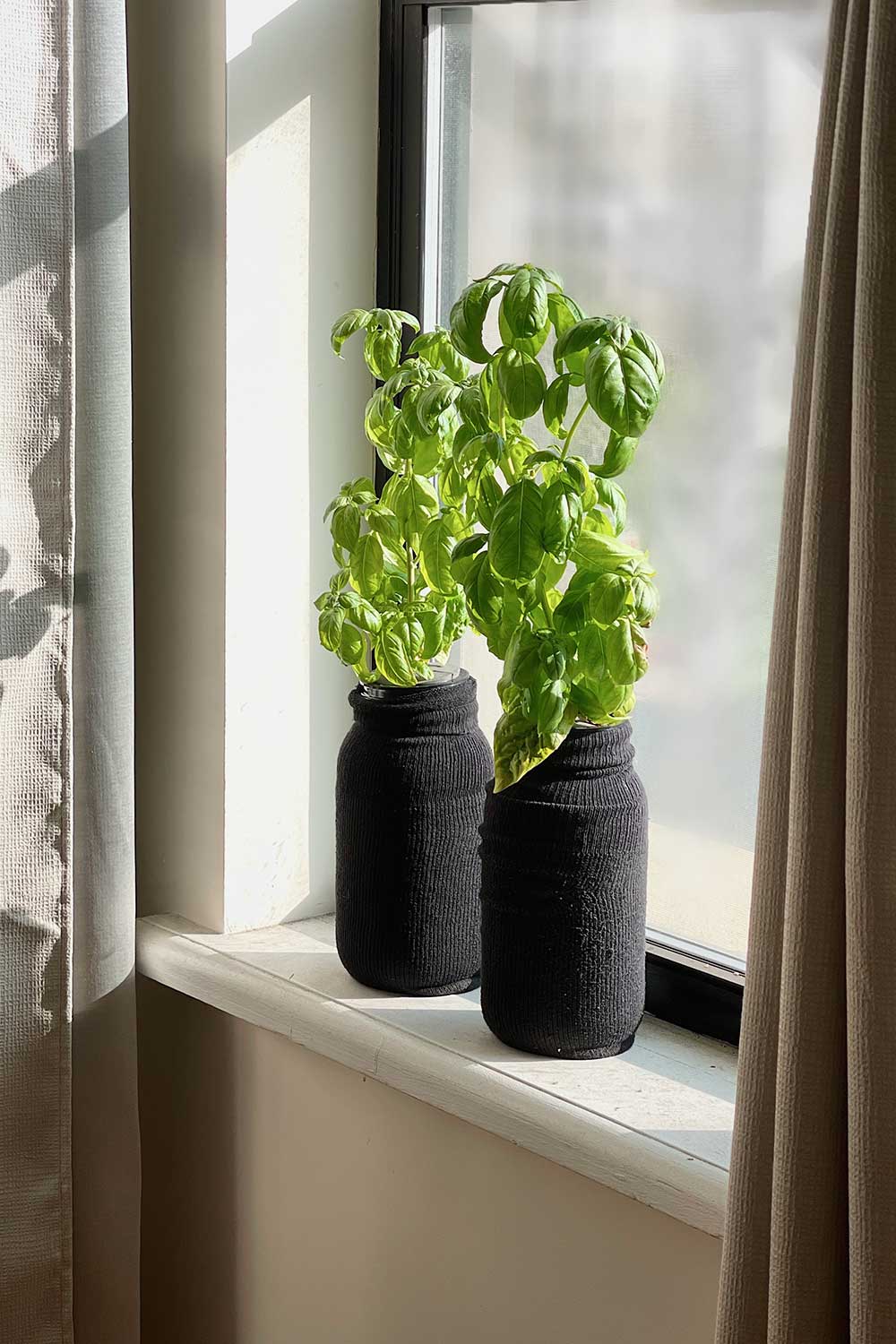

some things i’ve grown indoors.. and cooked/eaten!
.
Can You Grow Tomatoes Indoors?
Yes!
Tomato plants can get very large in the wild, so you have to be careful to source the right seeds.
I have a whole post on compact tomato varieties that are more indoor-garden friendly in this post.
But yes, it’s possible to grow cherry tomatoes, small roma sized tomatoes and even compact slicing tomatoes indoors.
With tomatoes, you want to ensure you provide them adequate lighting and nutrition.
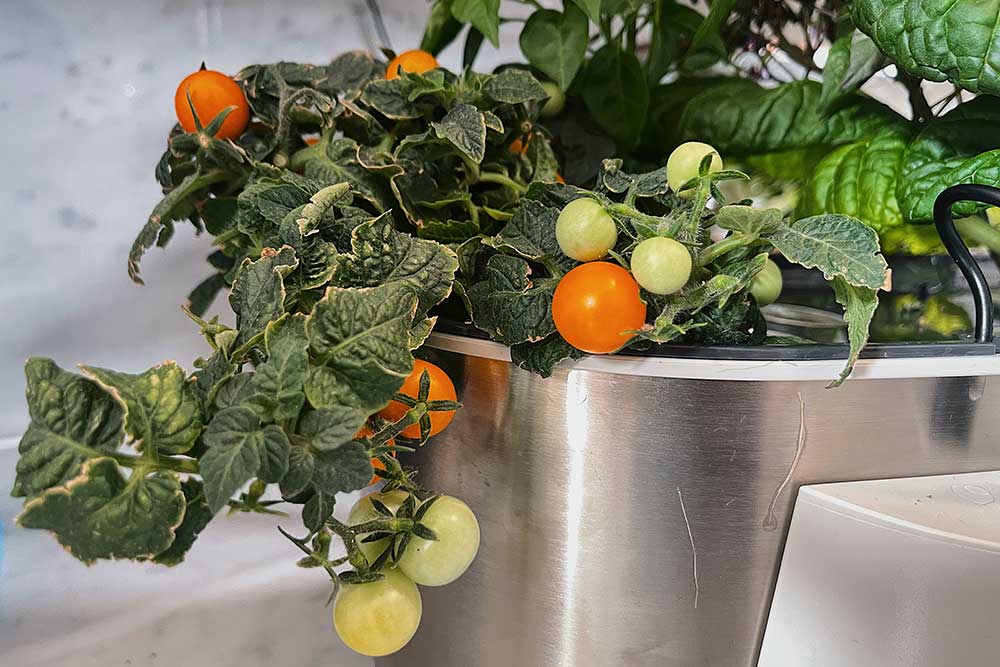
I’ve found that cherry tomatoes grow best in the Aerogarden Bounty vs the Harvest. These were super sweet + delicious
.
How Long Does It Take to Grow a Pepper Plant?

Pepper plants are one of the plants that take the longest to grow.
On average, it takes about 6 months from seed to start seeing peppers. And then, some peppers can take a while to mature and change color from unripe (green) to ripe.
But, I find it incredibly rewarding to grow hot peppers! They’re one of my favorite things to grow.
.
What Are Your Favorite Asian Greens to Grow Indoors?
I used to hate vegetables, ha, but now I love Asian greens.
In particular, I’m a big fan of baby bok choy, gailan, yu choy, choy sum!
But I’ve also grown tatsoi, chijimisai, mizuna, bush beans, shishito peppers, mitsuba, thai basil and more.
To grow Asian vegetables, I recommend starting from seed.
I get most of my seeds from Kitazawa and Botanical Interests. I’ve found that Kitazawa has the most authentic varieties of Asian vegetable seeds, so I always look there first.
Other seed companies I like are Baker’s Creek, Renee’s Garden and West Coast Seeds.
- Kitazawa has the best selection of classic, authentic Asian seeds
- Botanical Interests has great deals on heirloom seeds
- Renee’s Garden has a great selection of compact, container friendly varieties
- West Coast Seeds has some Asian seeds as well!
.
Can You Grow Watermelon Indoors?
It’s totally possible to grow watermelon indoors!
I’d recommend choosing a container friendly variety that will be compact.
I also recommend using a grow tent with grow lights since watermelon plants send out vines and they can easily overwhelm an uncovered garden.
But, watermelons need several months to grow and typically only 1 watermelon should be allowed to grow per plant.
So I wouldn’t say it’s the most efficient use of time or money.
At some point, I’ll try growing different melons indoors!
.
How Much Maintenance Is Involved?
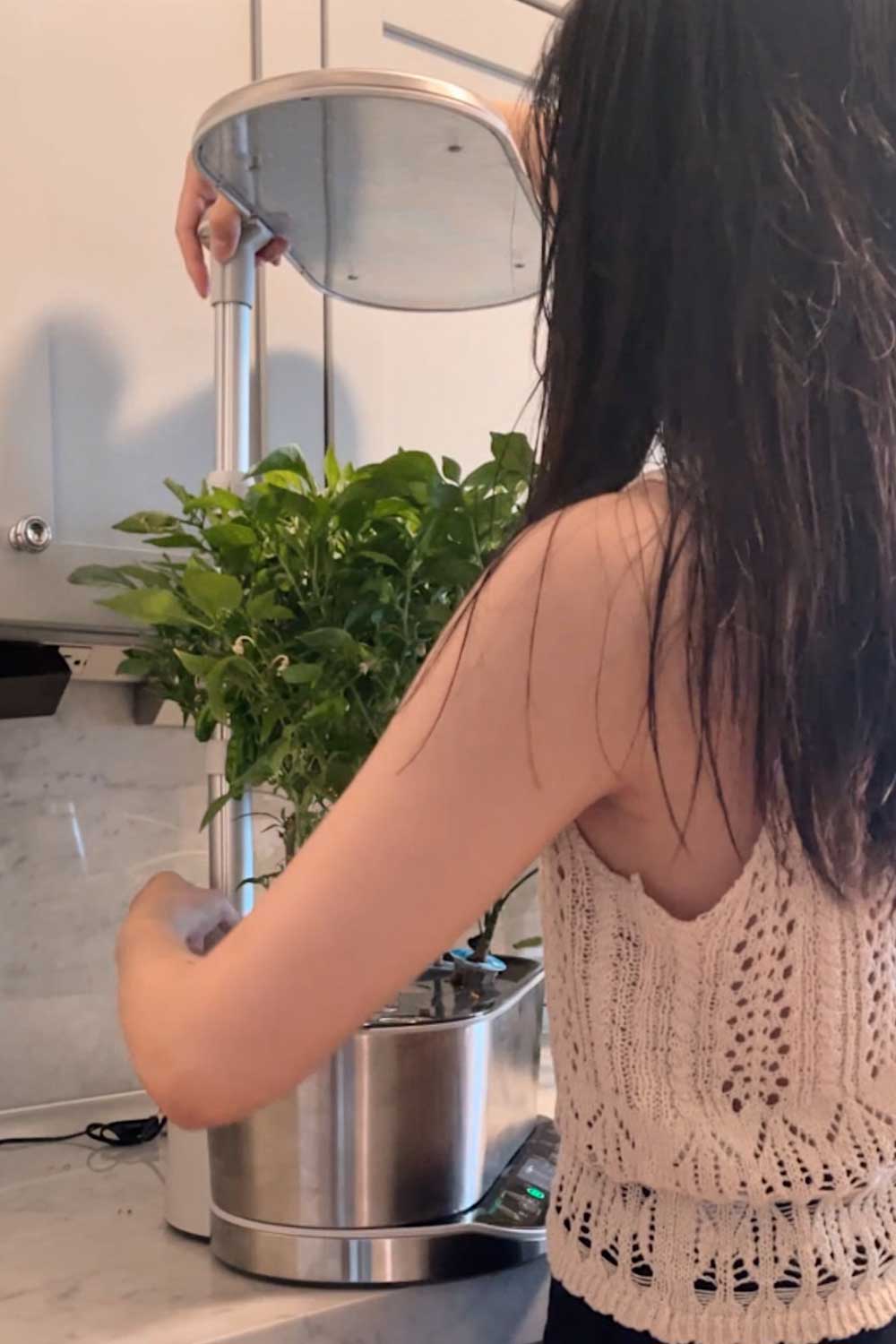
Not too much!
In the beginning, there’s a bit of learning curve to figuring out how to start seeds, prune, harvest, etc but after a while it all becomes very straightforward.
On a weekly basis, I’ll typically do a quick check of the gardens as I make my coffee. I’ll raise the lights if the plants are too tall, add nutrition if I need to, or refill the water tank.
For fruiting plants, I’ll hand pollinate the flowers in the beginning to ensure the plants produce fruit. But after a while, the plants seem to produce on their own and don’t need help.
In general, I’d say maybe 30 minutes of maintenance a week? So very little!
Indoor gardens take care of everything for you, thanks to their built in timer, LED lights and water pumps.
.
What Type of Nutrition Do You Use?
Lately I’ve been experimenting with all different types of nutrition.
For beginners, I’d recommend the Aerogarden nutrients.
They come in liquid form and don’t need to be mixed or adjusted. Simply pour a couple capfuls into your garden based on the instructions.
I find that the Aerogarden nutrients are a great well-rounded nutrient mix for every type of plant – herbs, lettuces, salad greens and fruiting plants.
For people already familiar with indoor gardening, I like Maxigrow and Bloom. I have a more in-depth guide to alternative nutrients here.
Both of these come in powder form, so you’ll need to add them to a gallon of water and mix them yourself.
But, they are much more cost effective and one bag of each will last me well over a year.
When you have multiple gardens and lots of plants growing, they’re easy to use in bulk and cheap!
In particular, I recommend Bloom for any fruiting plants like cherry tomatoes and hot peppers. They provide extra potassium which plants need to produce flowers.
The more flowers per plant, the more chances of fruit!
Read more: The Best Aerogarden Nutrient Alternatives.
How Often Do You Change the Water?
Some people are very precise with their hydroponic gardens and measure their water’s pH level frequently.
You can do this with a pH meter.
Over time as you add nutrients and the plants consume the water nutrient solution, leftover nutrients can alter the acidity of the grow tank.
So, it’s a good idea to completely empty the water tank and start with fresh water and nutrients every couple months or so.
With that being said… I never do that, ha.
I don’t have the time or desire to empty out all my indoor gardens’ water tanks and I find that my plants do just fine!
I also don’t measure my water’s pH but if you’re having trouble getting your plants to fruit or produce, then it’s something you can look into.
I experimented with my nutrients and feeding timeline until I found a consistent, easy-to-maintain schedule. And.. I just keep going with it unless I run into issues!
I’m pretty hands off with indoor gardening.
.
Do You Have Advice for Getting Started?
I recommend getting an Aerogarden Harvest to start out.
It’s a 6 pod garden that neatly fits on a kitchen countertop and is easy to set up.
It comes with pre-seeded pods so you can grow your own fresh herbs right away – expect to be able to harvest basil and the others in ~2.5 months.
The gardens handle most of the heavy lifting for you, so just make sure to maintain enough water in the garden.
Add nutrients every 2 weeks (the garden will remind you!) and prune the plants to encourage low, bushy growth.
It’s pretty easy!
.
Do You Throw Away the Plant Once You Harvest the Leaves?
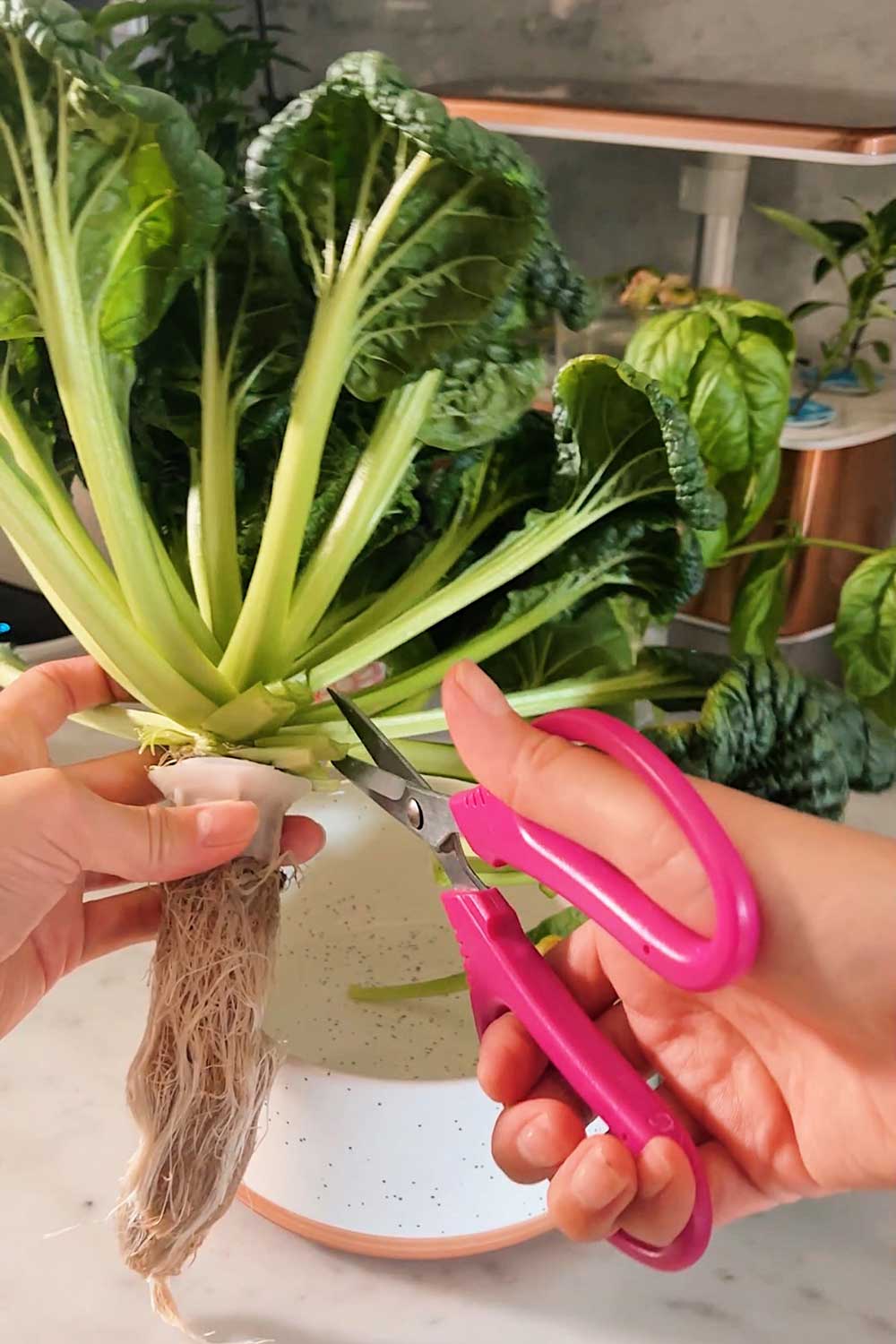
Typically I harvest leaves off my greens and eat them on a weekly basis.
It’s called the ‘cut and come again’ method where you remove the outer leaves and let the plant continue to produce new leaves.
But, lettuces and salad greens have a limited life span – roughly ~2 to 3 months.
So after a certain point the plant will mature and go to seed as it prepares to die off.
Once I notice that my greens are reaching the end of their life span, I’ll harvest the entire plant and grow something new.
.
What About Gnats and Bugs?
Because hydroponics doesn’t use soil, there’s a much lower risk of bugs.
But, it’s also really important to maintain as clean an environment as possible. I typically don’t open the windows in the room where I have my indoor gardens and I change my clothes when I get home.
I do find that little pesky fruit flies can happen in the summer if I leave garbage out, so I don’t do that either.
In four years of growing indoors, I have had one incidence with aphids but was able to get rid of them relatively easily.
If you have an issue with bugs (even without indoor plants) I recommend this handy little contraption! It’s a sticky trap light that traps flying bugs but looks sleek.
.
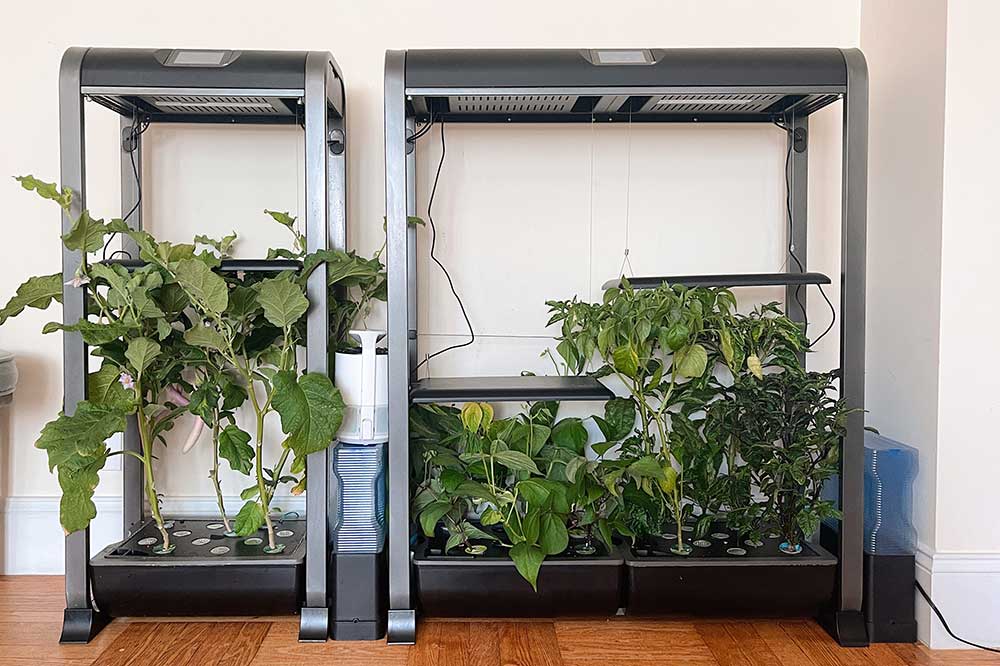
I have a handy white ‘bug catcher’ device sitting on top of the water reservoir, in between my Aerogarden Farms. It’s so compact and sleek you don’t even notice it!
How Expensive Is It to Maintain?
The main cost is the upfront expense of buying a smart garden.
They range in price, depending on the size and strength of the lights, but on average cost about $100 for a countertop model.
Try something like the Aerogarden Harvest or an Ahopegarden.
The ongoing maintenance costs are very minimal – electricity, seeds, water and nutrients. Maybe an extra $25-50 a year for replacement pods, seeds, utilities and plant food.
You can re-use the gardens year after year (I’m on year 5 at this point!) so in the long run, it’s very inexpensive.
I wouldn’t say I’m able to grow all my food indoors and avoid the grocery store altogether – it’s more of a fun hobby for me.
But not an expensive hobby!
.
Is It Worth It?
I think so!
Growing my own veggies indoors has brought me lots of joy ha.
I like growing new varieties of plants and vegetables that I never even knew existed, and I also find it fun trying to cook with them!
Follow me on
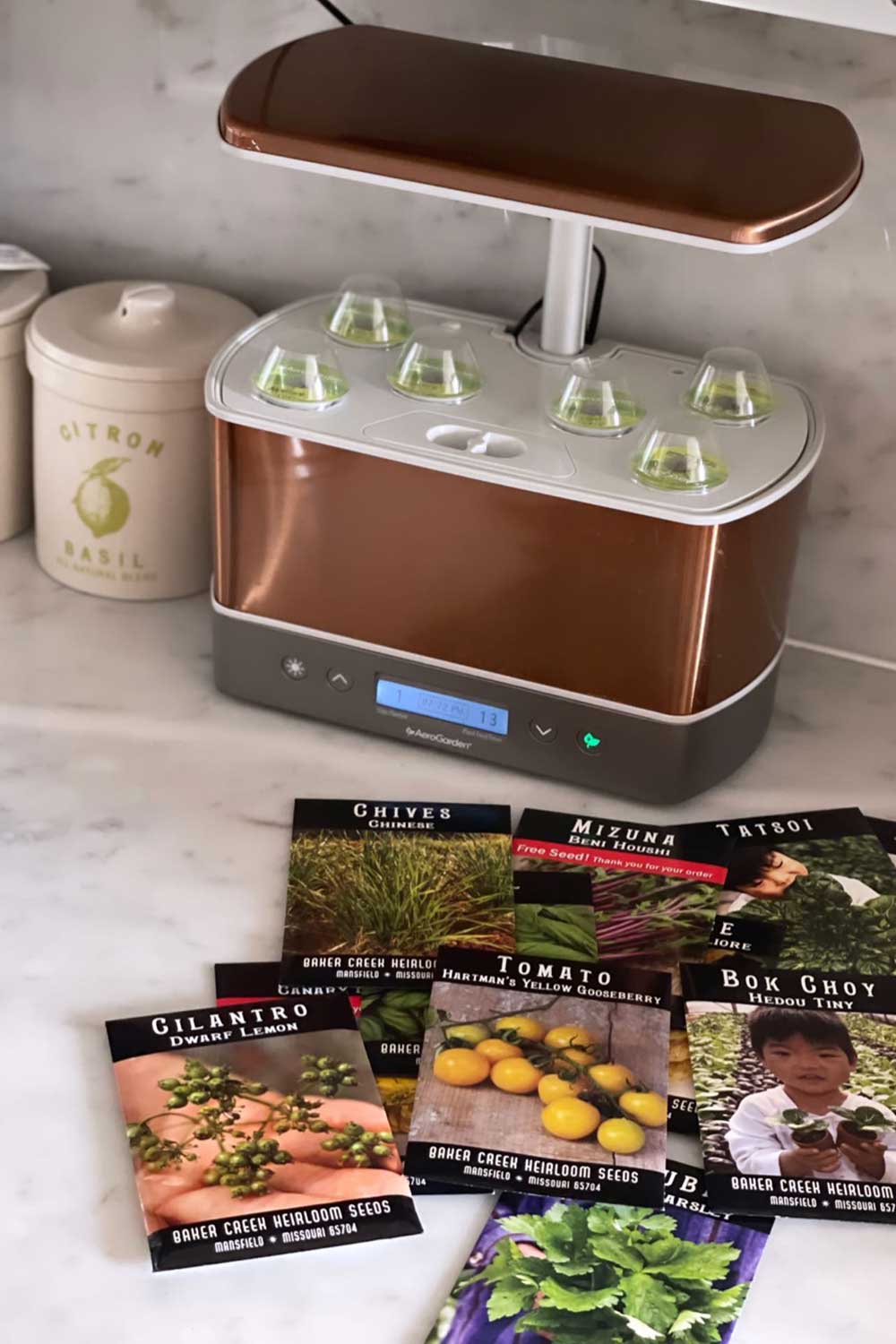
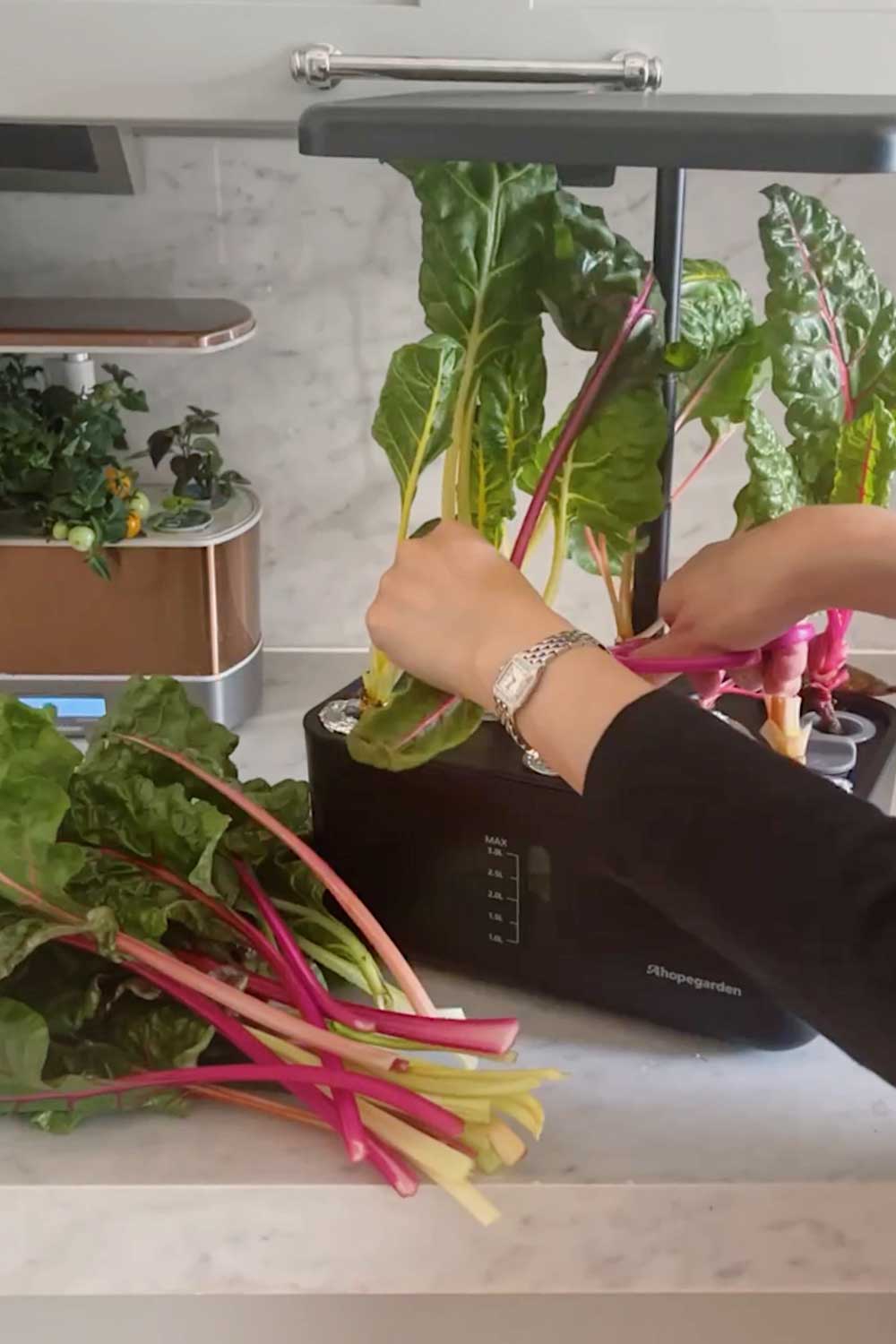
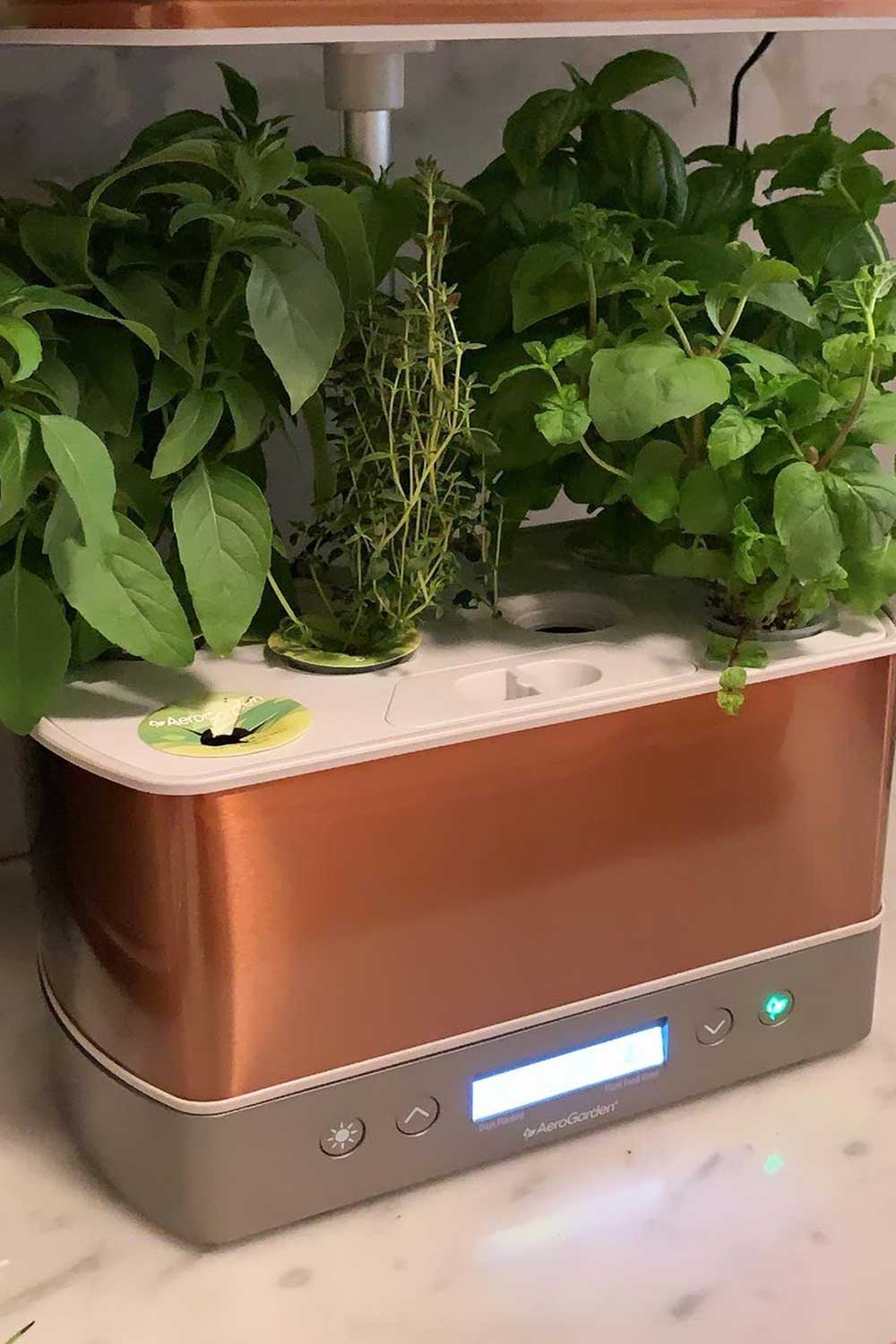
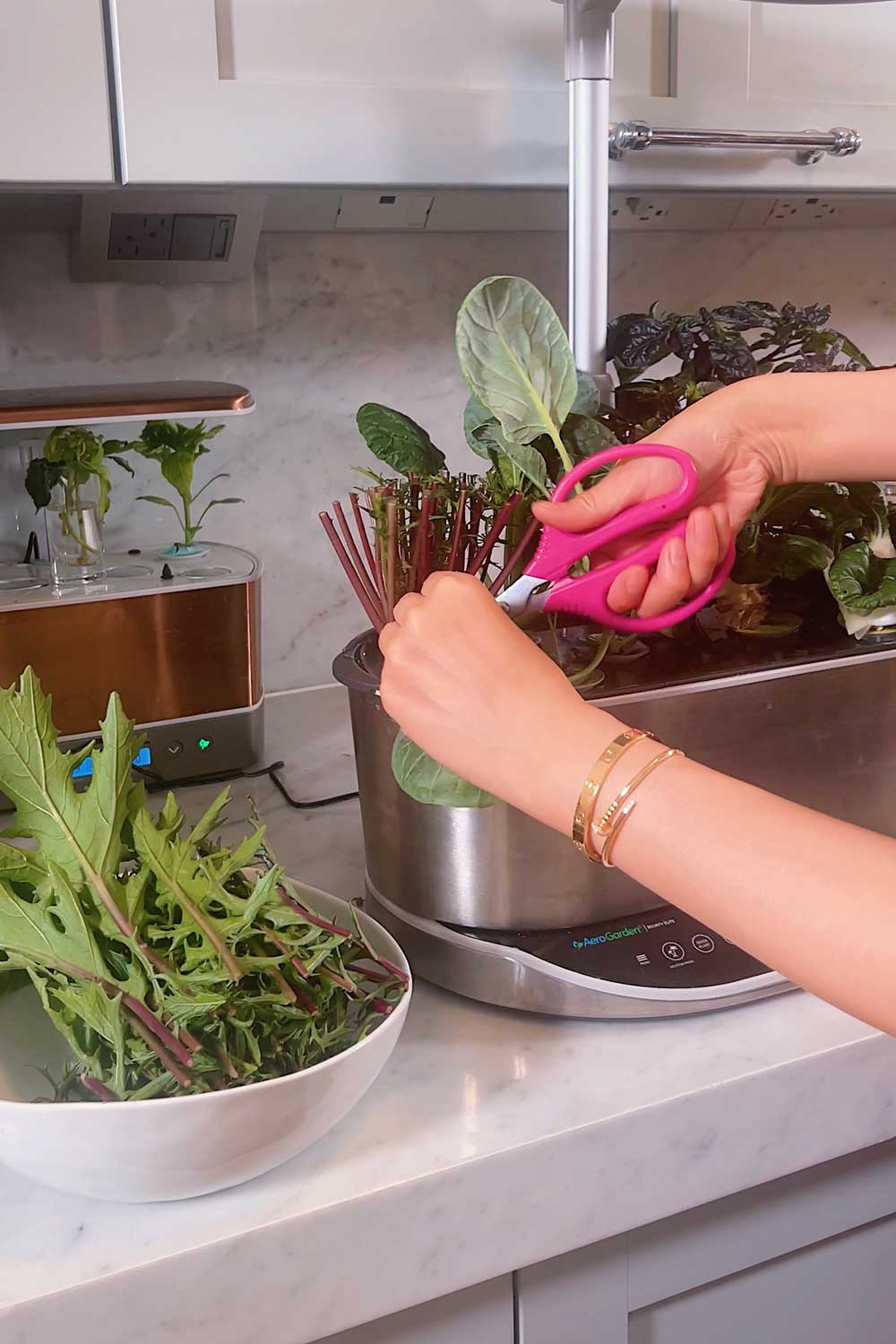
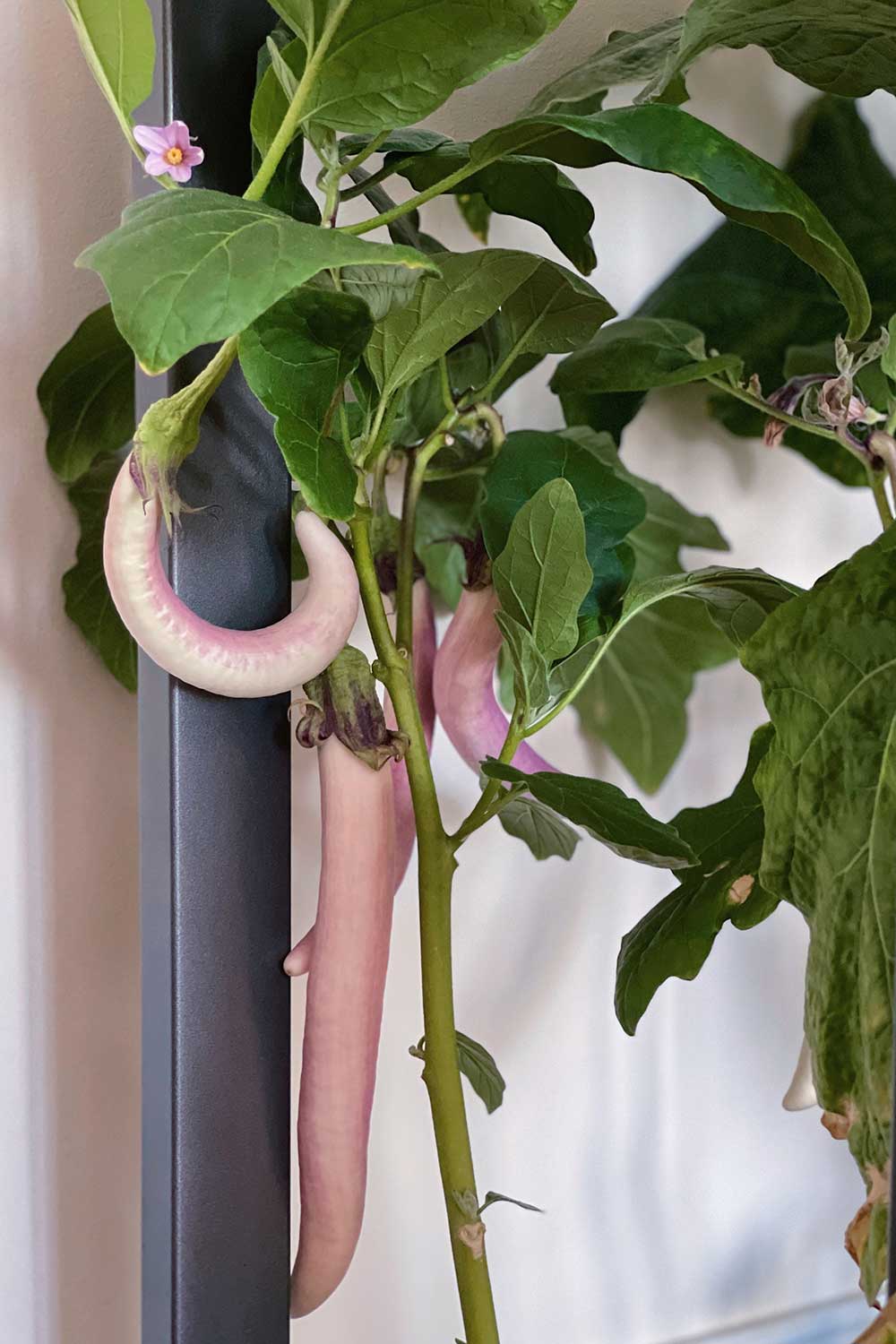
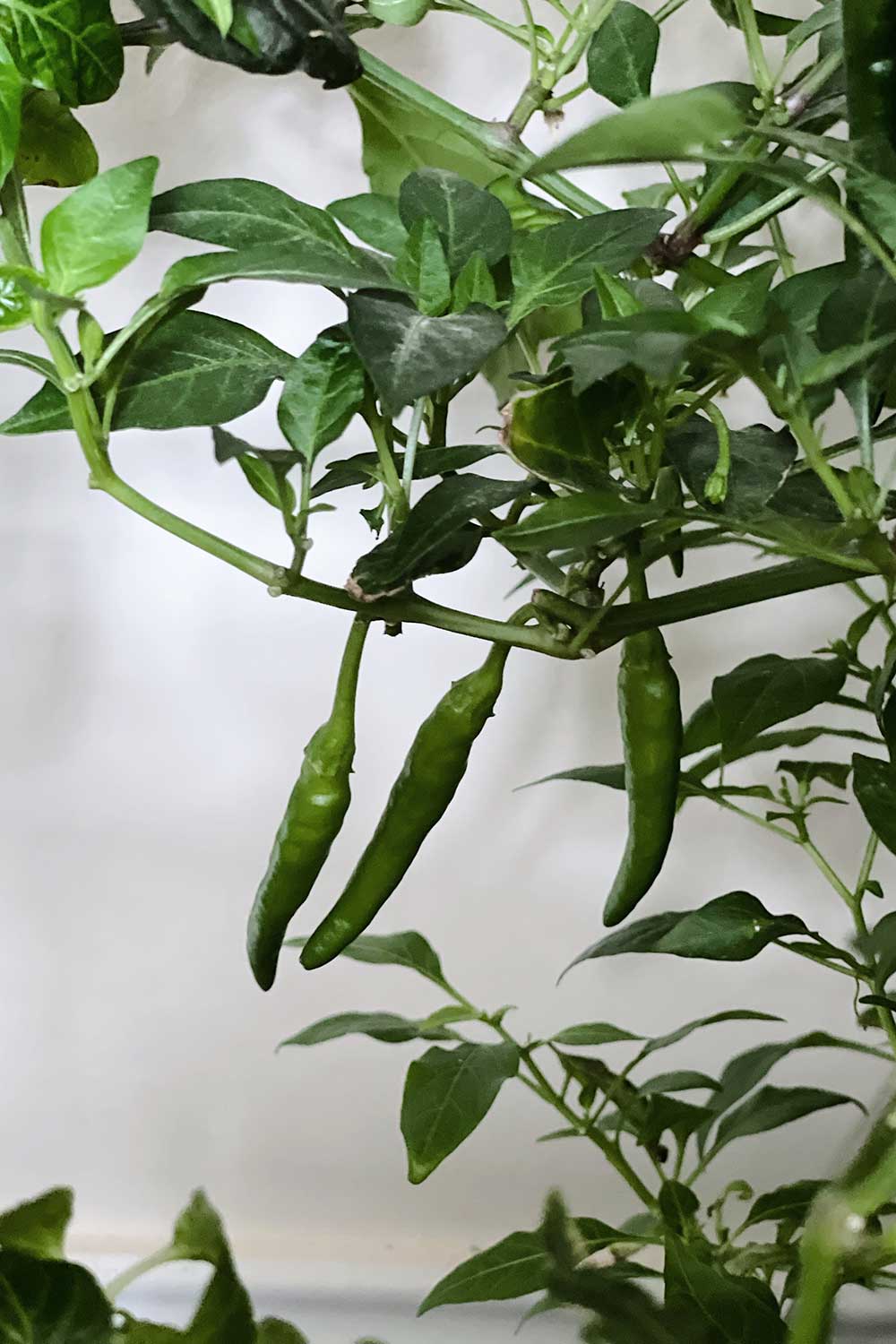
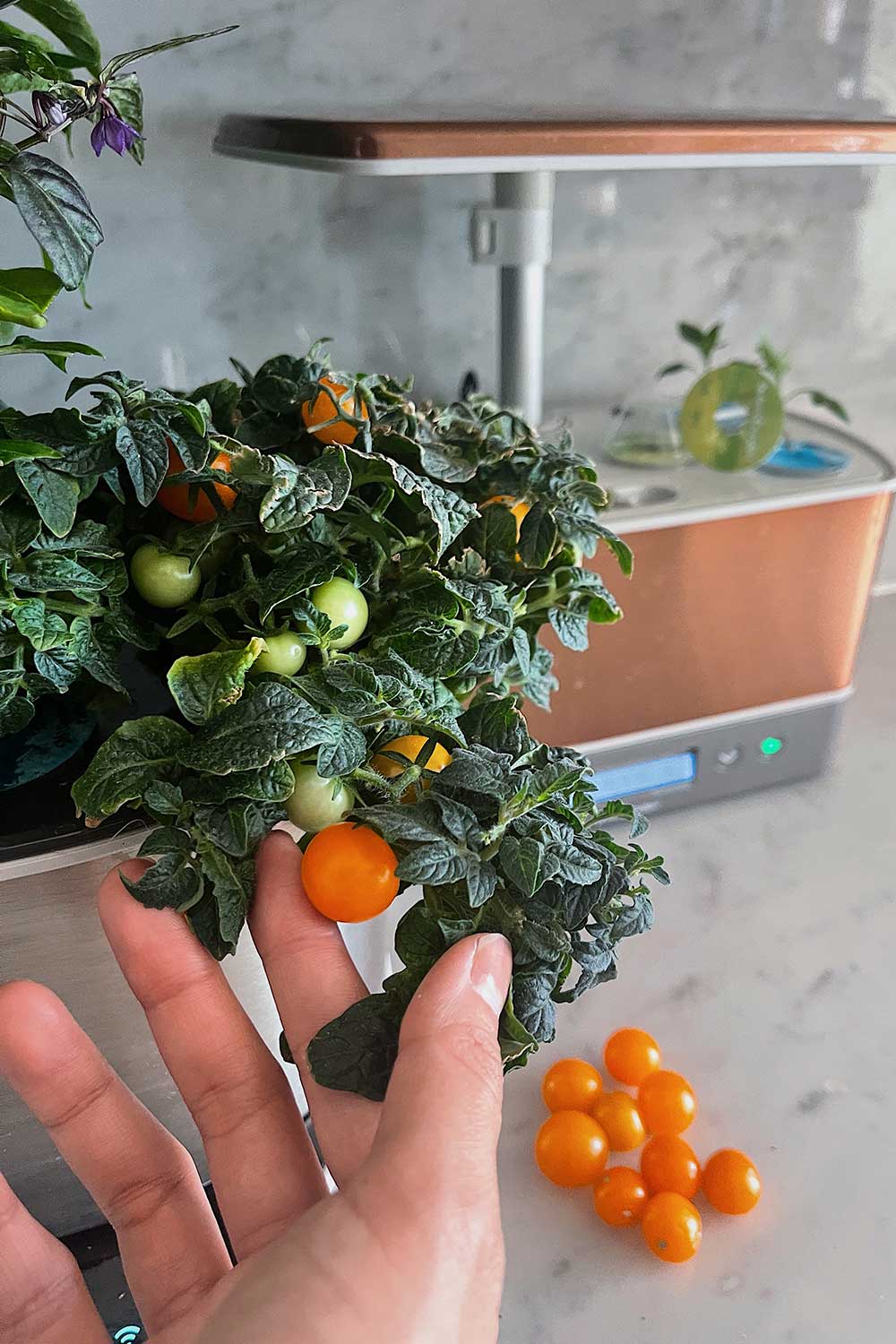
Hello
I love your detailed explanations.
I would like to know if you can trust Aerogarden nutrients, as they teamed up with Miracle Grow, the company that was sued for having sprays that cause cancer. How do you know that the nutrients you are using are organic and contain no harmful chemicals?
Also, which garden would be able to generate enough salad ingredients so that one can make a salad for 2 people every day?
Thank you very much
Author
Hi Diana,
If you’re concerned about Miracle Grow, you don’t have to use Aerogarden nutrients. There are many different brands of hydroponic nutrients, and right now I use this brand’s powder version.
But, I think you may be confusing the nutrients needed to grow plants in hydroponics with fertilizers.
All the plants I grow are pesticide free (i don’t spray any chemicals on the leaves or fruit, the part I’m actually eating). That’s how I know the plants are organic.
The nutrients that are poured into the grow bowl are not organic. They’re a combination of minerals (nitrogen, potassium, calcium etc) to help the plants grow. Minerals are not certified organic or not-organic, they’re just minerals. So you can’t really find ‘organic’ hydroponic nutrients.
In any case, the nutrients are very different from pesticides (sprays to kill bugs that are sprayed directly on the plant)!
Garden options:
This Click + Grow or Aerogarden or this cheaper Amazon garden would be a good option for salad! But if you want a full head of lettuce every day, continuously, you may need multiple units.